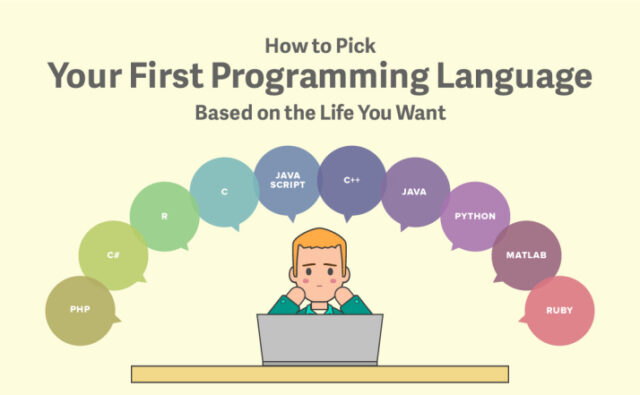
For beginners, there are so many programming languages, how do you choose one? How to choose your 1st programming language is a challenge. There are so many languages. Where do you begin? How do you pick your 1st programming language for your needs?
How To Pick Your 1st Programming Language?
There are at least three types of programming languages:
- Image or Picture Languages — these languages teach computer science and programming concepts through the manipulation of images. Turtle Art is a great example.
- Block or Bubble Languages — these languages use blocks and sometimes actual code to perform tasks, for example, spinning an image or making an image follow a specified route. Scratch, Tynker, and several other languages are examples. These languages bridge the gap between picture languages and traditional languages.
- “Real” Programming Languages — these languages are what adults think of as programming languages. Often obscure and inscrutable at times, programming languages can be learned step by step as people learn how to perform tasks and create applications. Python, PHP, Erlang, JavaScript, and perhaps thousands of other languages fit into this category.
It is rare for first-time coders to pick a programming language the way you might pick a video game from a wall of many video games. Instead, coders learn their first language in several possible ways:
- In grade school, they’re exposed to Turtle Art, Scratch, Tynker, or similar language to learn basic concepts and have some fun playing with coding.
- They finally get a computer science or programming class in middle or high school. Often this means VBScript is the first formal language they learn.
- They want to modify a favorite game by coding a mod. So they do their research, and learn what they need to know by trial and error. Sometimes this means Lua is their first language; however, it could be another game-specific language like Papyrus for Skyrim.
- They literally start anywhere. Perhaps they install WordPress or Drupal then read the documentation and thereby learn PHP. Or they see a jQuery or JavaScript effect they like on a web page and reverse engineer the effect, then move deeper into JavaScript. Or they have a parent or other adult who programs professionally and helps them get started.
Choices for Your First Programming Language
Beyond the issue of how to migrate from learning your first language to proficiency in that language, there are many languages to consider when you choose your first programming language. If you have a choice of what language to learn first, and you don’t have a desire to mod your favorite game or reverse engineer a neat effect you saw on a web page, these languages are worth a look:
- PHP is used in a number of open source projects like Drupal, Joomla, and WordPress with extensive documentation, forums, online communities, and other support. First-time coders can find ways to use their PHP skills over time to gain proficiency. Even though some professional coders look down on PHP, it’s a good first language. Best case, you’ll grow as a coder and know first hand any limitations of PHP, instead of simply repeating what others might say.
- Python is used by Google and other technically-oriented coding shops. It has excellent documentation, forums, books, and other help. Unlike PHP, where you code scripts then run them by calling up the scripts in a web browser, Python also works from a command line, especially for learning the language. I find a lot of Python coders are university trained coders and have highly structured ways they think about coding problems and solutions. That’s actually good if you’re a first time coder with plans to take high school and university classes in software programming.
- Lua is a simple tightly written language used in machines, games, and a wide range of applications. Most people encounter Lua while trying to mod Minecraft or other games. And Lua is available for direct use in Codea, the iPad app that is an excellent transition from drag and drop bubble languages like Scratch to actual coding. Lua syntax, the way the language is written, is clean like Python code, which can make the code easier to read than PHP, which uses curly braces and semi-colons like C, .NET, and other languages.
Choosing Your First Programming Language
With two or three possible languages in mind, research what kinds of support is available online. Research how the language is used in the real world. Research where you can get help learning each language. For example, knowing someone who can help answer questions when you get stuck might work best if you want to learn on your own or take online classes. All programming languages have nuances learned over time. They’re passed on person to person.
If you cannot find a programmer to help from time to time, also look into local Meetup groups and check them out. While coding is a solitary activity, meetups and having someone to answer questions are very important to your development as a programmer. This infographic helps you figure out to how pick your 1st programming language.













